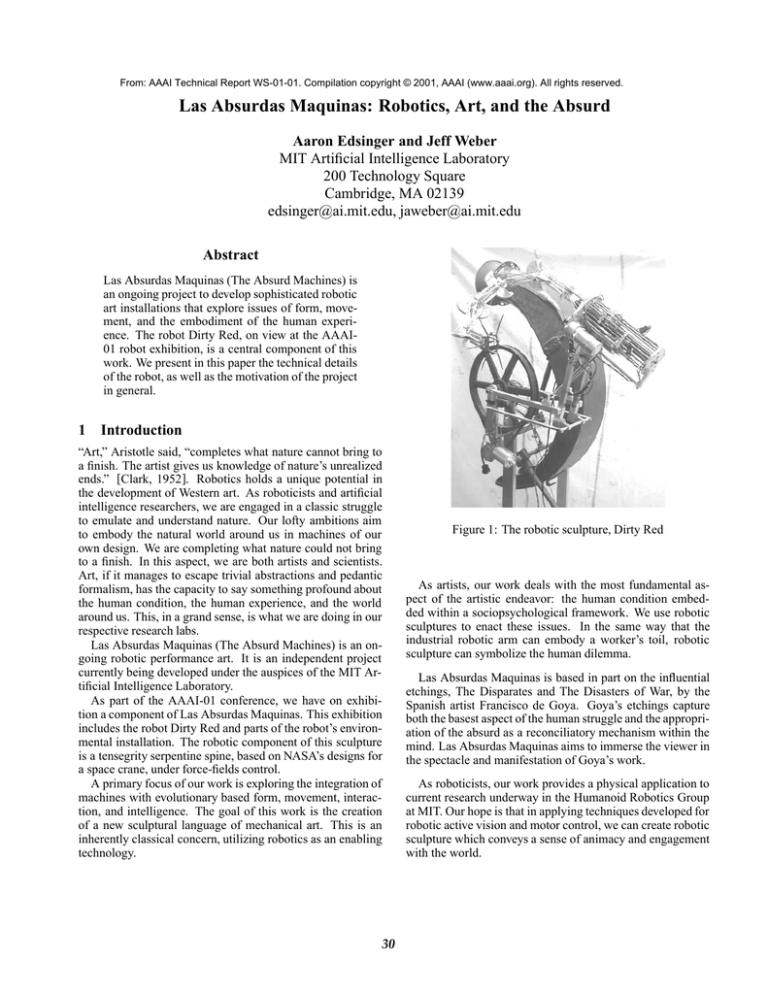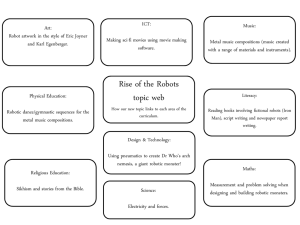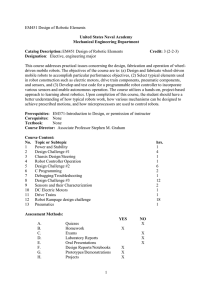
From: AAAI Technical Report WS-01-01. Compilation copyright © 2001, AAAI (www.aaai.org). All rights reserved.
Las Absurdas Maquinas: Robotics, Art, and the Absurd
Aaron Edsinger and Jeff Weber
MIT Artificial Intelligence Laboratory
200 Technology Square
Cambridge, MA 02139
edsinger@ai.mit.edu, jaweber@ai.mit.edu
Abstract
Las Absurdas Maquinas (The Absurd Machines) is
an ongoing project to develop sophisticated robotic
art installations that explore issues of form, movement, and the embodiment of the human experience. The robot Dirty Red, on view at the AAAI01 robot exhibition, is a central component of this
work. We present in this paper the technical details
of the robot, as well as the motivation of the project
in general.
1 Introduction
“Art,” Aristotle said, “completes what nature cannot bring to
a finish. The artist gives us knowledge of nature’s unrealized
ends.” [Clark, 1952 ]. Robotics holds a unique potential in
the development of Western art. As roboticists and artificial
intelligence researchers, we are engaged in a classic struggle
to emulate and understand nature. Our lofty ambitions aim
to embody the natural world around us in machines of our
own design. We are completing what nature could not bring
to a finish. In this aspect, we are both artists and scientists.
Art, if it manages to escape trivial abstractions and pedantic
formalism, has the capacity to say something profound about
the human condition, the human experience, and the world
around us. This, in a grand sense, is what we are doing in our
respective research labs.
Las Absurdas Maquinas (The Absurd Machines) is an ongoing robotic performance art. It is an independent project
currently being developed under the auspices of the MIT Artificial Intelligence Laboratory.
As part of the AAAI-01 conference, we have on exhibition a component of Las Absurdas Maquinas. This exhibition
includes the robot Dirty Red and parts of the robot’s environmental installation. The robotic component of this sculpture
is a tensegrity serpentine spine, based on NASA’s designs for
a space crane, under force-fields control.
A primary focus of our work is exploring the integration of
machines with evolutionary based form, movement, interaction, and intelligence. The goal of this work is the creation
of a new sculptural language of mechanical art. This is an
inherently classical concern, utilizing robotics as an enabling
technology.
30
Figure 1: The robotic sculpture, Dirty Red
As artists, our work deals with the most fundamental aspect of the artistic endeavor: the human condition embedded within a sociopsychological framework. We use robotic
sculptures to enact these issues. In the same way that the
industrial robotic arm can embody a worker’s toil, robotic
sculpture can symbolize the human dilemma.
Las Absurdas Maquinas is based in part on the influential
etchings, The Disparates and The Disasters of War, by the
Spanish artist Francisco de Goya. Goya’s etchings capture
both the basest aspect of the human struggle and the appropriation of the absurd as a reconciliatory mechanism within the
mind. Las Absurdas Maquinas aims to immerse the viewer in
the spectacle and manifestation of Goya’s work.
As roboticists, our work provides a physical application to
current research underway in the Humanoid Robotics Group
at MIT. Our hope is that in applying techniques developed for
robotic active vision and motor control, we can create robotic
sculpture which conveys a sense of animacy and engagement
with the world.
2 Background
Robotic sculpture dates back to the ancient Greeks. In fact,
the earliest robots were conceived for entertainment purposes.
Hero of Alexandria (c. 85AD) wrote a treatise entitled ”On
Automatic Theaters, On Pneumatics, and On Mechanics” in
which he described a number of small hydraulic powered statues, including a robotic reenactment of Hercules slaying a
dragon. These first robots were entertainment devices by necessity. In a striking parallel to the state of modern robotics,
robots of ancient Greece were only socioeconomically viable
in an animatronic form [Rosheim, 1994 ]. Later, Leonardo
da Vinci would pursue the work of Hero of Alexandria. Da
Vinci, it is purported, constructed a mechanical lion which
would walk across the stage and, opening its chest, deliver a
bouquet of flowers to the king of France, Francis I.
These early robots were a wonderful mix of artistry and
technological advancement. They were bound by dreams of
replicating human and animal forms in machines. At the core
of this early work we find the long-standing urge to recreate
reality through our own means, for man to recreate himself
through technological devices. We can find this drive towards
realism throughout the history of Western art. As modern
robotics researchers, we are extending a well developed history of artistic realism. Robotics and artificial intelligence
add a unique component to this history. As we develop cognitive architectures and models of intelligence, and embody
them in our robots, the reality we seek to replicate becomes
much more profound than the surface reality pursued by the
Greeks.
The modern conception of robotic art began with the Russian artist Naum Gabo and his sculpture Kinetic Construction (Standing Wave, 1920). More significantly, the work
of Swiss sculptor Jean Tinguely defined a strong formal language of industrial machinery merged with kinetic movement
(Figure 2. Much of the current sculptural aesthetic of robotic
art harkens back to Tinguely’s work. “Life is movement”,
Tinguely has said. “Everything transforms itself, everything
modifies itself ceaselessly, and to try to stop it... seems to
me a mockery of the intensity of life.” [Violand-Hobi, 1997 ]
These pioneers of modern robotic art were foremost concerned with the movement of the sculpture. After thousands
of years of predominantly static statuary, sculpture finally
seemed to come alive.
Survival Research Laboratories (SRL) [Pauline, 2001 ],
headed by artist Mark Pauline, has defined much of the current mode of robotic performance art. Over the last twenty
years, SRL has put on numerous live performances. According to SRL, each performance consists of a unique set
of ritualized interactions between machines, robots, and special effects devices, employed in developing themes of sociopolitical satire.
Las Absurdas Maquinas grew out of work done with another robotic performance group, the Omnicircus [Garvey et
al., 2001 ]. The Omnicircus group incorporates robotic performers with music, video, and theater to form a high-tech
industrial-surrealist art installation. A seminal work by this
group is the robot One Legged Men at a Butt Kicking Contest (Figure 3).
31
Figure 2: Chaos I by Jean Tinguely
Figure 3: The One Legged Men at a Butt Kicking Contest by
Aaron Edsinger and Jeff Weber
3 Technical Details
The robot Dirty Red (Figure 1) is a principal sculpture in
the Las Absurdas Maquinas project. In its latest incarnation,
Dirty Red has four degrees of freedom (DOF), including: a
one DOF body pan, a one DOF crossed four-bar linkage arm
(Figure 5), and a two DOF tensegrity spine (Figure 4). All
actuators are 24V DC motors, using either encoders or potentiometers for position feedback. Dirty Red also utilizes a
single CCD camera for visual feedback (not present in the exhibition). Position and velocity control is maintained on the
robot using a daisy-chained RS-485 network of PIC based
motor control cards. A Windows based host laptop performs
supervisory control and perceptual computations.
The tensegrity spine design has a lineage going as far back
as Da Vinci’s drawings for winged flight mechanisms. More
recently, the work of Shigeo Hirose [Hirose, 1993 ] has explored similar serpentine robots. The spine used in Dirty
Red is derived from NASA’s design for the Space Crane
[Rosheim, 1994 ]. Functionally, the tensegrity spine is four
universal joints stacked in series (Figure 6). Including the
Figure 4: The tensegrity spine of Dirty Red
Figure 6: A tensegrity spine joint.
´
¾
µ¾
(1)
where is the error in position, is the range of the velocity
field, and is the power of the velocity field.
We are actively exploring perceptual systems for Dirty Red
to enhance the animacy and interactivity of the robot. One
such system currently under development, is an active vision
system that will allow the robot to interact dynamically with
the viewer. We have drawn from work on the MIT robots,
Cog and Kismet [Brezeal, 2000; Brooks et al., 1998 ], for insight into developing a cognitive architecture for Dirty Red.
One component developed for this work is a human eyetracking subsystem [Brezeal et al., 2000 ]. This perceptual
ability will allow the robot to engage the viewer by roughly
directing its actions towards the viewer.
Figure 5: The crossed four-bar linkage arm and cable drive
mechanism of Dirty Red .
4 Las Absurdas Maquinas
drive box, the spine measures roughly four feet in length, and
is constructed primarily of machined aluminum and UHMW
polyethylene for the cable guides. All joints are driven in tandem along each axis through a cable-drive system. Cables
are routed through the center of each universal joint. This
creates a serpentine structure that moves in a manner similar
to an elephant trunk. We utilized the spine design to allow
for graceful and organic motion with minimal DOF. However, like most serpentine designs, mechanical issues of cable
routing, tension, and stretch complicate the control and the
robustness of the mechanism significantly.
Control of the spine is achieved through a velocity-fields
approach called Bounded Linear Attractors [Brooks, 1999;
Arkin, 1998 ]. The idea behind this method is to have the attractive or repulsive velocity be linear with the position error
in joint space. We bound the velocity through multiplication
by a normalized gaussian to obtain smooth and bounded velocity gradients (Equation 1). This allows for gradual relaxation to the spine’s target position.
Las Absurdas Maquinas encompasses an ambitious endeavor
to manifest the primal and social forces of the human psyche in a multimedia robotic installation. Robotic performance
art holds a unique potential to represent the complexities of
the human experience in a robotic form. In their early Greek
conception, robots were liturgical tools and entertainment devices. The modern conception of the robot has shifted to that
of a machine designed to assist humans in tedious tasks. Las
Absurdas Maquinas returns to the original Greek inspiration.
We hope to utilize modern day robotics to create synthetic
characters which can exist as symbols of the human dilemma.
The symbolic embodiment of the robot is illustrated by the
advent of the industrial robot arm towards the end of the last
century. Even though the inception of the industrial robot was
driven by an economic, and not artistic impetus, the factory
robot has the assumed the stature of a symbol. Designed to
remove the worker from the drudgery of menial tasks, this
robot has come to represent the victory of technology over
toil. The industrial robot arm has assumed the role of Sisyphus, the Greek tragic figure condemned to rolling a boulder
up a hill for eternity.
32
We can see this idea again in a robotic panhandler sculpture named Go-Boy by artist Frank Garvey [Garvey et al.,
2001]. Garvey took the robot to the streets to panhandle
from pedestrians. Onlookers were confronted with a beggar which, though mechanized, still elicited the complexity
of emotions often experienced with the homeless. However,
because Go-Boy is simply a machine not an actual human,
the social niceties often fall away when interacting with the
robot. Actual dialogue, directed at the robot, includes: “That
is wrong”, “It is ugly, people don’t want to see that”, and
“I’d like to see the first robotic panhandler get arrested.’ GoBoy demonstrated the potential for robotic works to magnify
social stresses and embody components of the human experience.
As we build robots to exhibit many of the deeper complexities of the human psyche, they can become symbols of human capacity and embodiments of our struggles, thoughts,
and emotions. This is the direction that the Las Absurdas
Maquinas project is working towards.
References
[Arkin, 1998 ] Ronald Arkin. Behavior Based Robotics. The
MIT Press, Cambridge, MA, 1998.
[Brezeal et al., 2000 ] Cynthia Brezeal, Aaron Edsinger, Paul
Fitzpatrick, Brian Scassellati, and Paulina Varchavskaia.
Social constraints on animate vision. IEEE Intelligent Systems, 2000.
[Brezeal, 2000 ] C. Brezeal. Sociable Machines: Expressive
Social Exchange Between Humans and Robots. PhD thesis, Department of Electrical Engineering and Computer
Science, MIT, Cambridge, MA, 2000.
[Brooks et al., 1998 ] R.A. Brooks, C. Brezeal, et al. Alternative essences of intelligence: Lessons from embodied
ai. In Proceedings of the American Association of Artificial Intelligence Conference (AAAI-98), pages 961–998.
AAAI Press, 1998.
[Brooks, 1999 ] Rodney Brooks. Cambrian Intelligence: The
Early History of the New AI. MIT Press, Cambridge, MA,
1999.
[Clark, 1952 ] Kenneth Clark. The Nude: A Study in Ideal
Form, chapter 1. Princeton University Press, Princeton,
1952.
[Garvey et al., 2001 ] Frank Garvey, Aaron Edsinger,
and Jeff Weber.
Omnicircus multimedia theater.
www.omnicircus.com, 2001.
[Hirose, 1993 ] Shigeo Hirose.
Biologically Inspired
Robots(Snake-like Locomotor and Manipulator). Oxford
University Press, 1993.
[Pauline, 2001 ] Mark Pauline. Survival research laboratories. www.srl.org, 2001.
[Rosheim, 1994 ] Mark E. Rosheim. Robot Evolution. The
Development of Anthrobotics. John Wiley and Sons, Inc,
1994.
[Violand-Hobi, 1997 ] Heidi Violand-Hobi. Jean Tinguely:
Life and Work. Prestel USA, August 1997.
33






